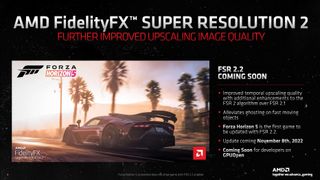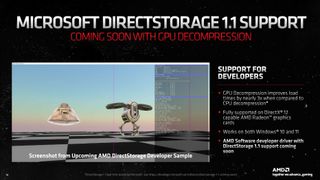AMD Talks FidelityFX Super Resolution 2.2, ISV Engagement
The most successful FidelityFX feature

Along with the announcement of the RDNA 3 architecture and the Radeon RX 7900 series graphics cards, AMD also briefed us on its gaming and ISV (independent software vendor) relations and the adoption of some of its GPUOpen technologies. We also have another article on the Radeon Software and Platform ecosystem. Check out those articles for additional content, but let's talk about FidelityFX Super Resolution (FSR) — by far the most successful of AMD's FidelityFX offerings to date.
After just over a year since FSR 1.0 first became available, and about six months since FSR 2.0 arrived, AMD says FSR is now in 218 current and upcoming games and applications, and it's a safe bet that more will continue to come. It has a website tracking the list of FSR-enabled games (note that you'll want to click on Super Resolution, as the list also tracks games with other FidelityFX features), though that list is apparently only updated on occasion.
There's a separate AMD community thread that shows all the currently available and upcoming games with FSR 2 support, which honestly is far more interesting. There are presently 46 games listed there with some form of FSR 2 support, including 30 with FSR 2.1 and a single FSR 2.2 game. There are also 55 upcoming games that will have FSR 2 support. That's great to see, and it clearly illustrates the rapidly increasing adoption rates of FSR 2.
If we go back to the main FidelityFX page, you can see just how much FSR use there is compared to other features. There are only 46 games that use FidelityFX CAS (Contrast Aware Sharpening), five with FidelityFX Ambient Occlusion, four with Variable Shading, five with Denoiser, one that uses the HDR Mapper, eight with Downsampler, and one that uses FidelityFX Screen Space Reflections. All of those combined are thus only about a quarter of the number of FSR-enabled games.
AMD also pointed out how FSR has been gaining ground on DLSS, and while we do have to note that FSR 1.0 integration is far easier since it uses spatial upscaling, the latest figures for FSR 2 look quite promising. 46 released and 55 pending is less than the 250+ or whatever DLSS-enabled games, but virtually universal GPU support should make it easier to convince developers to include FSR 2. Nvidia's DLLS 3 meanwhile currently lists 35 announced games, with about 10 being currently available.

New to the party is FSR 2.2, which offers further tuning of the FSR 2 algorithm to help eliminate ghosting on fast moving objects. Forza Horizon 5 got official public support for FSR 2.2 on November 8, and in related news, the same patch also added DLSS 2, DLAA, and TAA support — which is great and makes perfect sense, as all of those take the same core inputs: z-buffer, motion vectors, current frame, and the previous frame(s).
Limited testing (on the GeForce RTX 4080 that is now available) didn't seem to work for some reason, but I've revisited the game and found that things seem to be working properly now. Except a bunch of the game settings have changed with these new additions and determining which option is "best" has become a lot more complex.
4K Extreme settings (with DXR now) on an RTX 3060 gave 32.7 fps for 2x MSAAA, 39.1 fps for DLAA, 44.7 fps for FSR 2.2 Quality, 45.5 fps for DLSS 2 Quality, and 49.0 fps for TAA with CAS (ultra quality on the CAS). Winner in performance: TAA+CAS. Winner in visual fidelity: ¯\_(ツ)_/¯ (It's probably a topic to try and dig into deeper at some future date when I have more time.)
With Nvidia now promoting DLSS 3's Frame Generation feature, AMD is also looking to answer with FSR 3 sometime next year. It will use "Fluid Motion Frames" to generate an additional frame, and like DLSS 3 it will potentially add (at least) one frame of latency while boosting framerates. There aren't any games with FSR 3 support announced just yet, but we'll be keeping an eye on it in the coming months.
We're also curious to see if AMD will stick to its "works everywhere" approach, as we've seen with FSR 1 and FSR 2. Nvidia made a lot of comments about the need for the Optical Flow Accelerator in its Ada Lovelace GPUs to support DLSS 3, though there are questions about whether it's truly required and whether the OFA in Ampere might be sufficient. AMD does have some AI Accelerator functionality in its RDNA 2 and RDNA 3 architectures, and perhaps those could be of use with FSR 3, but it seems likely the company will try to keep the support "universal."

AMD also talked about its support for DirectStorage 1.1, which should be available soon and should run on all RDNA 2 and RDNA 3 graphics cards. It will also work with Nvidia RTX cards and Intel Arc GPUs. Now, all we really need is the public release of games that actually support the feature. I for one would love to see stuff like Flight Simulator leverage DS1.1 and perhaps cut down loading times from well over a minute to perhaps just a few seconds. Make it so, Microsoft!
And AMD also talked about working with various companies to get its tech adopted in gaming engines. That obviously happens with Nvidia and Intel as well, but ultimately the proof is in the eating of the pudding, and the bigger your slice of the graphics card market, the easier it is to get ISVs to use your features. It's one of the big advantages Nvidia continues to have, as its GPUs account for 75–80 percent of the gaming market, according to Steam's Hardware Survey.
But again, AMD's advantage here is that FSR and FSR 2 work with any GPU. If it can deliver reasonably comparable image quality and performance to DLSS 2 while working on everything from AMD's latest cards to old R9 and Nvidia GTX GPUs, that has to be worthy of praise.
The full slide deck is below for those who want to dig further into the details of what AMD covered on these topics.


















- MORE: Best Graphics Cards
- MORE: GPU Benchmarks and Hierarchy
- MORE: All Graphics Content
Stay On the Cutting Edge: Get the Tom's Hardware Newsletter
Get Tom's Hardware's best news and in-depth reviews, straight to your inbox.
Jarred Walton is a senior editor at Tom's Hardware focusing on everything GPU. He has been working as a tech journalist since 2004, writing for AnandTech, Maximum PC, and PC Gamer. From the first S3 Virge '3D decelerators' to today's GPUs, Jarred keeps up with all the latest graphics trends and is the one to ask about game performance.
-
-Fran- They added FSR2 into Genshin Impact... To use as AA... What the hell xDReply
Anyway, good to see FSR adoption is rather healthy and they keep tweaking it.
Regards.
Most Popular





